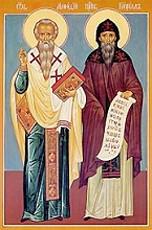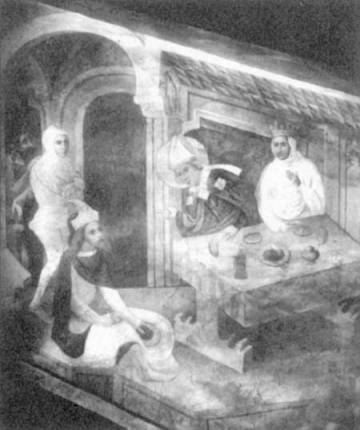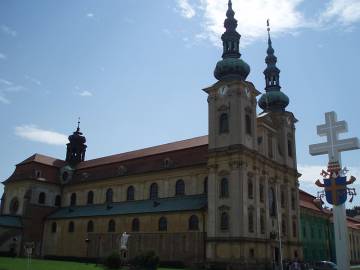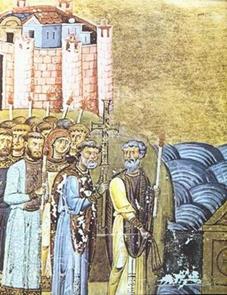The mysterious tomb of Methodius
Categories: Castles, strongholds and extinct places

Methodius' grave, one of the most mysterious topics in Czech history. Both amateur researchers and serious archaeologists are searching for it. Two surviving vague records written in Old Slavonic not long after Methodius' death may serve as clues in the search. On the 6th day of the month of April, in the 3rd indication of the year 6393 from the creation of the world... They laid him to rest in the chapter house." As for the final resting place, another manuscript, Proložnoye zhitiye Konstantina i Mefodija, is somewhat more specific: "... He lies then in the great Moravian temple on the left side behind the altar of the Holy Mother of God, placing his soul in the hands of God..."
Methodius' tomb was long placed on Velehrad. The present Velehrad, however, has nothing in common with the Great Moravian one. Nevertheless, the grave of St. Methodius was most often found in its wider surroundings, especially at the "fortress of St. Methodius" just a few kilometres away. Clement", where the ruins of St. Clement's church stood amidst the ramparts from the Great Moravian period. In 1700, Florian Nezorin, the provost of the Velehrad monastery, sought it here, in 1724 Count Albert Kounic and many others. However, their search was unsuccessful.
In 1904, Brázdil, a parish priest from Auschwitz, and Robert Čechmánek, a postal clerk, joined the search with other enthusiasts. After uncovering the foundations of an ancient, but probably not Great Moravian church, they found bones and a piece of decayed wood on the site. This was enough for them to declare that they had discovered the grave of St. Methodius and part of his bishop's crutch.
After the experts examined the find, they concluded that, apart from the fragments of animal bones and a piece of wood from the coffin, the remains of at least four people were involved. In 1958, Klimentka, as this hill in Chřibská is called, was investigated by archaeologist PhDr. Vladimír Ondruš and found that the grave with the bones discovered by Robert Čechmánek belongs to the 14th century, where the Augustinian monastery used to stand.
Klementina Maštalířová, a Stupava housewife and folk clairvoyant, also carried out research in the vicinity of Osvětiman in 1926. S ARČIBIS METODĚEI PROS ZA NAS U BOHA and an engraving of a mitre were found by hired diggers on June 1932 on the aforementioned graves, called U Metuda. However, the remains of Methodius themselves were not there. However, Mashtalirova claimed that they would be there, but they would have to dig deeper; she said that the remains of St. Louis were even lying by Methodius' side. By then there was quite a stir about the digging at Auschwitz, stirred up by the journalists. While experts were sceptical about the discovery, as the terrain at the site was at first sight sterile and untouched by man, thousands of simple pilgrims flocked from far away, out of curiosity and simple faith. The diggers excavated a pit 22 metres deep and hit the water table. The grave was nowhere to be found. So they began to enlarge the pit and on that occasion found another tombstone, broken into several pieces. And the pilgrims kept coming and business flourished. Photographs of the stones were sold, donations were collected, and dozens of hawkers and hawkers had their stalls. The authenticity of the finds was not to be doubted. And yet they were fake.

The leading Moravian archaeologist, Associate Professor Zdeněk Klanica, believes that the tomb of St Methodius has already been found. He has even published a book entitled: "The Mystery of the Tomb of the Moravian Archbishop Methodius". The author even documents that the grave was opened several times after the Archbishop's death and the body of St. Methodius was taken away. Of the remains, only the man's elbow bone was preserved in the grave. It lay on a special iron object, which was formerly thought to be a sword, and therefore the grave was not given due attention. Methodius' grave was sought elsewhere.
Dr. Z. Klanica considers it most probable that the congregational church - the largest in Moravia - must have been in the centre of the Great Moravian state, and this was the present-day site of Mikulčice near Hodonín. It is also where most of the church and other important buildings from the 9th century have been discovered. In his book, the author guides the reader along the traces of the life of Saint Methodius and gives an overview of the painstaking search for his alleged grave. In this context, he emphasizes several times that the Great Moravian archbishop - like the bishops of the West - "had to be armed", "could not fail to take part in the greatThe Archbishop of Byzantium could not have been absent from the military campaigns that were the order of the day", and that he himself had been an important state and political figure in Byzantium before his monasticism.
Initiatives after the Second World War

Communism after the Second World War was violently opposed to everything we have identified as the Magna Carta idea. On the other hand, Russia's situation in the political arena provided the opportunity for the proliferation of chairs of professors of Slavic studies in the world's universities, and for them to organize international meetings. Only one congress had a Cyril and Methodius character: in Salzburg in 1963, organized by the Hungarian Slovak Zagiba. An official delegation from Czechoslovakia was there, behaved politely and reported on the excavations at Velehrad. The question of Methodius' grave was raised there again, but to no avail. On the other hand, the discovery of the Roman relics of St. Cyril was successful. P. Boyle, a Dominican from St. Clement's in Rome, had the main credit for this. The relics were placed in a box prepared by Nepomucene in the altar in the upper chapel by Pope Paul VI, who attached importance to this fact. He was impressed by the great pilgrimage from Czechoslovakia, which took place unexpectedly under Dubček on 14 February. The second Roman initiative was the annual joint mass of the Slavic colleges at St Clement's on 14 February. The initiator of this event was P. Olšr of the Oriental Institute as the surviving head of the Velehrad Unity and postulator of the beatification of Stojan.
According to experts, only further excavations or improved DNA research could resolve the debate about the whereabouts of Methodius' remains.
Bauer, J.: THE BEGINNINGS OF CZECH HISTORY II., internet, viky
You can search for artefacts from this period using our metal detectors.
The article is included in categories:
